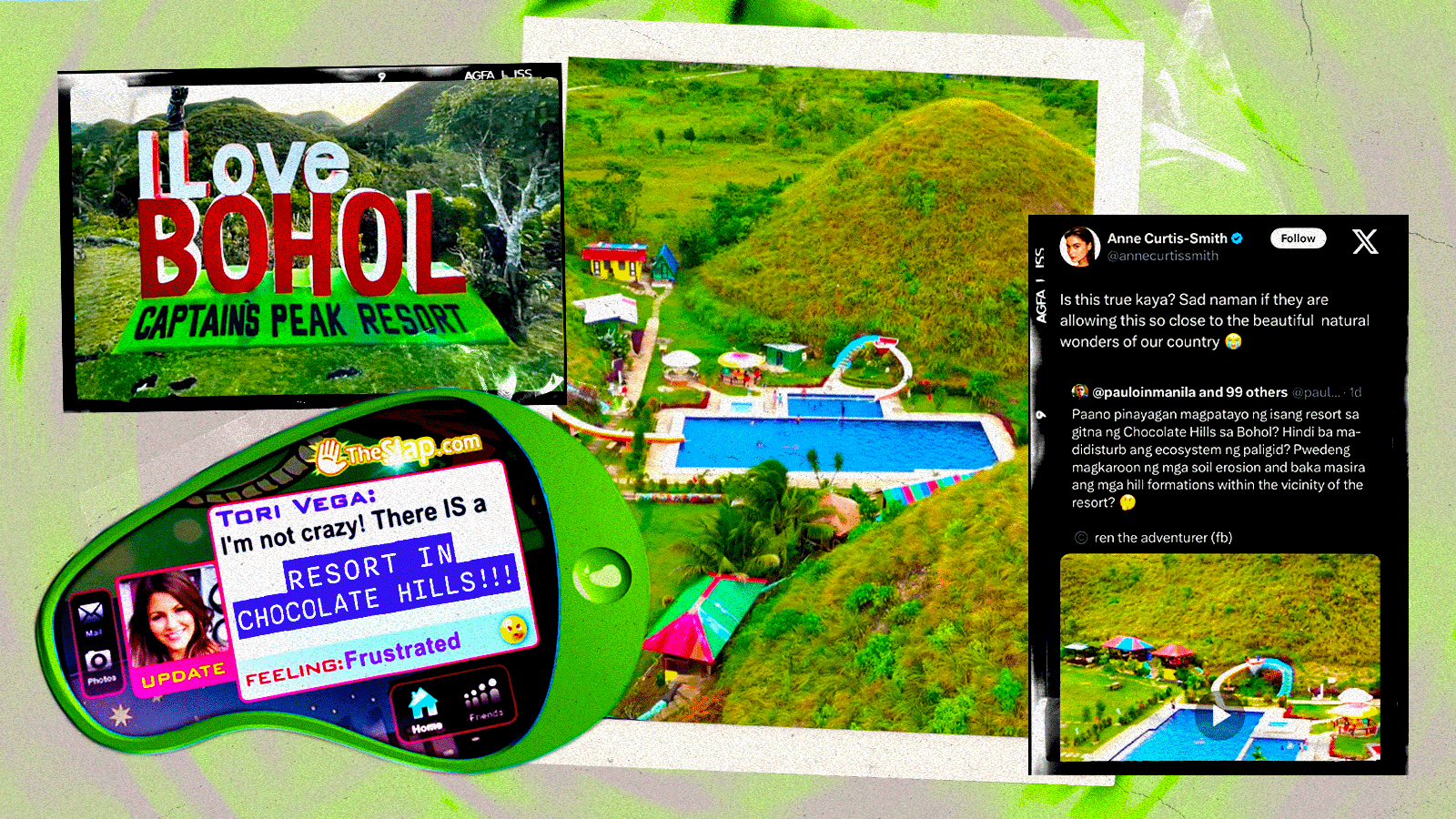The existence of the now-infamous Captain’s Peak Resort in the Chocolate Hills invites plenty of questions, and not a lot of answers.
Related: This People’s Museum In Manila Is Putting Climate Survivors’ Stories Front and Center
If you were on any social media platform recently, you must have seen the viral resort smack dab in the middle of the Chocolate Hills in Bohol. The Captain’s Peak Garden and Resort is a resort built right at the foot of some of the hills of the National Geological Monument and Protected Landscape.
As it gained visibility on social media, people were quick to react and criticize the construction of a resort on a protected area, not just for being disruptive to the view of the Hills that have become a popular tourist attraction and cultural symbol, but also for potentially posing harm to the environment.
Paano pinayagan magpatayo ng isang resort sa gitna ng Chocolate Hills sa Bohol? Hindi ba ma-didisturb ang ecosystem ng paligid? Pwedeng magkaroon ng mga soil erosion and baka masira ang mga hill formations within the vicinity of the resort? 🤔
— @pauloinmanila and 99 others (@pauloMDtweets) March 13, 2024
©️ ren the adventurer (fb) pic.twitter.com/ACFniLUKyM
It’s pretty surprising to many that a project like this was approved, given the increasing clamor for preserving and protecting important cultural landmarks in the Philippines. While pretty swift action from the Department of Environment and Natural Resources (DENR) has been taken to address the resort, it’s brought up some very relevant questions regarding business-government relations and communication, sustainability, cultural preservation, and more that many people have been asking. We explore some of these questions below in an effort to open discussion and maybe find some answers.
But first, what’s going on?
Is this true kaya? Sad naman if they are allowing this so close to the beautiful natural wonders of our country 😭 https://t.co/ITucIPrXll
— Anne Curtis-Smith (@annecurtissmith) March 13, 2024
The Captain’s Peak Resort is a resort with a pool, slides, and cottages nestled at the foot of several hills located in Sagbayan, Bohol. The Chocolate Hills are protected under law (Proclamation 1037) as a significant environmental and cultural natural monument, meant to be protected and preserved, and are on the tentative list for becoming a UNESCO World Heritage Site.
Establishing any sort of building or resort on a protected area requires the business or company’s compliance to restrictions and regulations imposed. An Environmental Compliance Certificate (ECC) detailing a project’s environmental impact must be issued for a project to continue with its construction. In the case of the resort, they were operating without an ECC, and—according to the resort manager—were actually allowed to.
DENR STATEMENT ON THE CHOCOLATE HILLS IN BOHOL pic.twitter.com/QaVtusEOWu
— Department of Environment and Natural Resources (@DENROfficial) March 13, 2024
According to the DENR, a temporary closure order was issued to the resort back in September 2023. The Sagbayan local government, though, said that they were never given the closure order. Now that the resort has been the subject of much public discourse, the DENR is taking action to investigate if the resort is in violation of any closure order, and for that matter, in violation of environmental regulations.
How did this get approved?
Incompetence? Hindi naman siguro overnight e napatayo yung resort sa Chocolate Hills? So bakit nung tinatayo na sya e hindi pinaimbestiga at pinatigil? https://t.co/yM72EoUjCd
— Teddy B. Baguilat (@TeddyBaguilatJr) March 13, 2024
If there was a closure order, it’s clear that there’s something wrong with the establishment and operations of Captain’s Peak. So was there no inquiry, investigation, or intervention held before or during its construction or anytime sooner?
The resort has been open since 2019, but was affected by the pandemic, forcing operations to officially begin in 2022. Regardless, is it not a matter of government systems not keeping a close eye on operations within their jurisdictions, especially in relation to the environmental impact these kinds of projects will undoubtedly have?
Or is it simply a case of a business operating despite not having the proper licenses and restrictions? The resort manager claims, and Senator and chairperson of the committee on tourism Nancy Binay confirms, that the Protected Area Management Board in charge of the Chocolate Hills area issued clearance on the construction and operation of Captain’s Peak. Senator Binay asked a very relevant question: how was such an establishment cleared to be built in the first place?
What possible damage does it pose?
The environmental concern—and the implied increasing threat of modernization to natural environment—take high priority in this whole thing. Construction itself has the potential to damage the environment and negatively affect the biodiversity in the area, and not just because the land itself is drastically changed. From fuel consumption to contamination, deforestation to the introduction of new materials and chemicals to the land, construction has a big environmental impact that can harm the life in the area.
Now that it’s built, the increase in population could also affect the biodiversity and landscape. Further, the resort may serve as a precedent to other businesses that it’s a permissible endeavor to build so close to environmental or cultural monuments, if you manage to skirt around the rules.
“While development is essential for growth and progress,” a statement from Tourism Secretary Christina Garcia Frasco reads. “It must be conducted in harmony with environmental and cultural preservation.” She goes on to say that development within the Chocolate Hills are not consistent with long-term sustainability.
Will the actions they’ll be taking actually be helpful or is it just for damage control?
A temporary closure order only grants the time to figure out what can be done regarding the operations of the resort. Given that there’s no way to reverse the impact Captain’s Peak now has on the area, everyone is curious to see how the resort, the local government, and the DENR will move forward.
Captain’s Peak has since issued an advisory that the resort will be temporarily closed for “maintenance and environmental preservation efforts.” It should be noted that the Facebook page embedded above was created only yesterday, and is different from this Facebook page that has been active since 2019. However, it is true that the resort has since ceased operations pending investigation.
As ocular inspections occur to find out exactly if or how Captain’s Peak is in violation of restrictions, we are left to wonder how it’s come to this point. While private property owners generally have a right to do whatever they want with their land within regulation, why was such a project allowed to proceed without anyone going, “hey, this might be a bad idea” in consideration of the protected area?
The Chocolate Hills was declared the country’s first geopark by the Unesco. Regardless when the resort was built, may our leaders and everyone uphold political will to conserve and preserve our natural heritage. Regardless of the details. No matter what it takes.
— Aya Fernandez (@ayafernandez_) March 13, 2024
Whether or not it is technically in violation of environmental and cultural restrictions and regulations is a different story. A resort being built on such a significant area in the name of development, profit, or the like, signals a bleak decrease in consideration of our natural resources, biodiversity, and the environment. And if people on social media didn’t blow this up, we wouldn’t have this response. Hopefully, the actions all parties will be taking will actually help more than harm—and that it’s not just damage control.
From the photobombing building in Luneta Park, to the Ateneo de Manila University carpark project that’s pushing through despite uproar, it’s high time our priorities as a society must be put into question. Policies, regulations, and systemic practices must also be scrutinized to be able to address issues like this far earlier than we’re doing right now. It also makes you wonder—what other similar things are happening right under our noses that haven’t made it to the larger public discourse?
Continue Reading: Here Are 7 Ways You Can Help Out The Environment In Your Local Community






